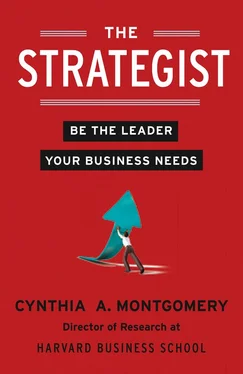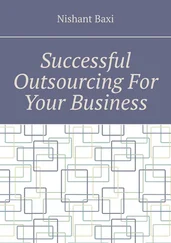In truth, it is. But the confidence every good strategist needs can readily balloon into overconfidence. A belief that is unspoken but implied in much management thinking and writing today is that a highly competent manager can produce success in virtually any situation. One writer calls this “the sense of omnipotence that plagues American management, the belief that no event or situation is too complex or too unpredictable to be brought under management control.” 1
I call this belief, when taken to its extreme, the myth of the super-manager. It seems to come naturally to many successful entrepreneurs and senior managers who see themselves as action-oriented problem solvers, confident doers for whom difficulties are daunting but solvable challenges. I see it behind Masco’s leap into furniture manufacturing and behind executives’ choice of the same path every time I teach the case. Confidence matters. But there’s much more to strategy and leadership than a steadfast belief that a daring vision backed by good management can overcome virtually all obstacles. Without the rest of it, “bold” too often becomes “reckless.”
Look at what such thinking did to Masco. Operating profitability dropped to half its historical average, and the firm’s stock price was lower when it left the furniture industry than when it entered ten years earlier. And money was only part of the cost. Where Wall Street had spoken of Masco as a “Master of the Mundane,” it began to speak of the company’s “past glory” and “bitter shareholders.” 2The company lost momentum as its leaders spent years distracted by a massive venture that ultimately failed.
For Masco, its move into furniture was a defining moment, but not a positive one. A legacy built over decades was shattered, an affirmation of a well-known Warren Buffett maxim: “It takes twenty years to build a reputation and five minutes to ruin it.” All because the strategist got this one choice wrong.
What happened?
Your instinct, like most managers’, is probably to seek the answer by looking at Masco itself and its leaders. Surely, the ultimate fault lies there. But to get the full picture, you must look as much outside as inside the firm.
Here is a first clue.
As our faculty team was preparing to teach the case for the first time, a colleague, the most senior in the room, said, “Wait a minute. This story sounds very familiar.” He left the meeting and went back to his office files. There he found “Mengel Company (A),” a case so old it was typed on onionskin paper.
Set in 1946, the Mengel case describes the firm’s plans to revolutionize the highly fragmented furniture industry. Mengel’s bold idea? Build scale, gain efficiencies by leveraging its manufacturing skills, and establish brand identity. To do this, it would buck industry practice and spend $500,000 on national advertising to “make the average consumer style-conscious” and build its “Permanized” brand name. 3I had never heard of Mengel, but with an eerie sense of déjà vu, I wondered if Masco’s leaders had known about them.
My own research in the industry led to the following list. What do you think these seemingly disparate companies have in common?
Consolidated Foods
Champion International
Mead
General Housewares
Ludlow
Intermark
Georgia Pacific
Beatrice Foods
Scott Paper
Burlington Industries
Gulf + Western
Like Mengel and Masco, these are all companies that tried and failed to find fortune in furniture manufacturing.
Most were regarded as well-run companies. Like Masco, they considered a fragmented, chaotic industry to be an opportunity for good managers to apply their skills. With great expectations and high hopes of success, they all jumped in with the intention of reshaping the industry through the infusion of “professional management.” Years later, they all left.
UNDERSTANDING THE FORCES
Most executives find this list both revealing and disconcerting. These were companies with considerable track records, yet they all failed in the same endeavor. Was there something problematic about the endeavor itself? Was something at work in the furniture industry that was outside the control of these companies and their leaders?
Here’s another clue.
Look at the chart on Relative Industry Profitability. It shows the average return on equity for twenty industries over the twenty-year period from 1990 to 2010. The chart was compiled from Standard & Poor’s and Compustat databases that include data on all companies that traded on U.S. stock exchanges.
Relative Industry Profitability: 1990–2010 Return on Equity
Are you surprised by how much profitability varies by industry? Compare Tobacco companies at 36.1 percent average annual return on equity—which means leading firms in the industry do even better—with Airlines at -10 percent or Commercial Equipment at -2 percent.
In my experience, most executives understand that average profitability will differ from industry to industry, but the scale of variation often comes as a surprise. Annual average returns in the most profitable industries are well more than double those in median industries, and more than four or five times those at the bottom of the distribution. Researchers have found similar differences in other countries, in both advanced and emerging economies. 4
Are these vast differences from industry to industry caused by random variation? It’s not likely—they’re too large and too consistent. Do some types of businesses attract great managers while others attract only poor ones? Sometimes, but not enough to account for the differences.
In fact, these variations are caused by economic forces that shape each industry’s competitive landscape differently. 5As Michael Porter has shown, some of these relate to the nature of rivalry within the industry itself; others have to do with the balance of power between the industry and its suppliers and customers, substitute products, and potential new entrants. Sometimes the forces are fierce and lead to low levels of industry profitability; other times they’re relatively benign and set the scene for much more profitable outcomes.
The collective impact of these forces on the profitability of individual firms, and, in turn, on industries in which they operate, is called the industry effect. You may be surprised to learn that some and perhaps much of your company’s performance is determined by such forces. 6
These competitive forces are beyond the control of most individual companies and their managers. They’re what you inherit, a reality that you have to deal with. It’s not that a firm can never change them, but in most cases it’s very difficult to do. The strategist’s first job is to understand them and how they affect the playing field where competition takes place.
MAKING THE DISTINCTIONS
As suggested by the above chart, industries can be arrayed along a continuum extending from “Unattractive” to “Attractive,” where attractiveness refers to the degree to which industry competitive forces restrict, allow, or even foster firm profitability. The table below identifies the most important of these economic forces and characterizes what they probably would be like in industries at the bounds of such a continuum. 7
| Unattractive……… |
|
………to Attractive |
| High. Many homogeneous competitors and homogeneous products. Innovations quickly copied. Slow growth. Excess capacity. Price competition. |
Rivalry among firms |
Low. One or a few dominant, differentiated players. Unique products. Strong brand identities. Rapid industry growth. Shortage of capacity. |
| High. Industry is dependent on a few, concentrated suppliers producing unique products, and Industry is not important source of profitability to suppliers. |
Power of suppliers |
Low. Many suppliers producing homogeneous products. Price competition and plentiful supply make it easy to procure supplies at reasonable cost. |
| High. Customers have lots of choice among similar products. Low levels of brand awareness. Low switching costs. Low levels of emotional involvement with purchase. |
Power of customers |
Low. Products are scarce, highly differentiated, and important to customers’ well-being. Customers have limited choice. Brands are strong. |
| Low. Industry is easy to enter and sometimes difficult to exit, creating excess capacity. Strategies of existing competitors can be easily replicated or surpassed. Entry requires low levels of capital, modest scale, and no scarce or specialized resources. |
Barriers to entry and exit |
High. It is difficult or not economical for new firms to enter your industry. Entry requires economies of scale, product differentiation, high capital investment, regulatory approval, or accumulation of special expertise or experience. |
| High. Wide variety of compelling substitute products are available that meet customers’ needs at attractive relative prices. |
Availability of substitute products |
Low. Customers have few or no choices of alternative products that could meet their needs at comparable prices. |
Note how closely many of the competitive conditions in furniture manufacturing mirror those in the left-hand “Unattractive” column.
Читать дальше








![Theresa Cheung - The Dream Dictionary from A to Z [Revised edition] - The Ultimate A–Z to Interpret the Secrets of Your Dreams](/books/692092/theresa-cheung-the-dream-dictionary-from-a-to-z-r-thumb.webp)



